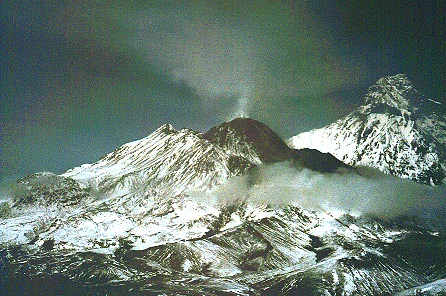Volcanoes
A Volcano is a vent in the earth through which hot gases and molten
rock rise to the surface. A coneshaped
mountain of erupted material around such a vent is also called a volcano. The name is
taken from Vulcano,
an island north of Sicily in the Mediterranean Sea. The island was given its name by the
ancient Romans
because it spewed smokelike vapor, and was thought to be the home of Vulcan, their god of
fire.

A Volcano consists of a fissure
in the earth's crust, above which a cone of volcanic material has accumulated. At the top
of the cone is a bowl-shaped vent called a crater. The cone is formed by the deposition of
molten or solid matter that flows or is ejected through the vent from the interior of the
earth. The study of volcanoes and volcanic phenomena is called volcanology. Most
volcanoes are composite landforms built up partly of lava flows and partly of fragmental
materials. Italy's Mount Etna, in Sicily is an example of a composite cone.
In successive eruptions, the solid materials fall around the vent on
the slopes of the cone, while lava streams issue from the vent and from fissures on the
flanks of the cone. Thus, the cone is built up of layers of fragmental materials and flows
of lava, all inclined outward away from the vent. Some enormous, craterlike basins, called
calderas, at the top of long-dormant or extinct volcanoes, are eventually occupied by deep
lakes, such as Crater Lake in Oregon. Some calderas are the result of cataclysmic
explosions that destroy the erupting volcano. Others form when the subterranean magma
chamber, emptied by repeated eruptions, can no longer support the weight of the volcanic
pile above it. Therefore it collapses.
Active and Dormant Volcanoes
Types of
Eruptions
Location
and Causes of Volcanoes
Home Page
Previous
Disaster Next
Disaster
